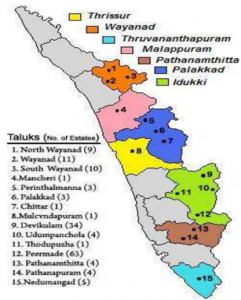Tea Clusters in Kerala, India Case Study Solution
SCM – Supply Chain Management
Upstream Processing:
Production:
The tea bushes that grow mostly in the up-hill stations in Kerala are first pruned. As it is a gardening technique used for healthy growth of the plant. This also improves circulation of air, and specifically removal of dead and diseased branches. Second step is the plucking of the tea leaves from the tea plant bushes. The harvesting of tea leaves is done by using hands but it does only involve picking of the young and juicy leaves.(Mrunal Patel, 2013) Though, the production of tea in Kerala has made a significant hike.In comparison to 1960s production, the tea production output has increased to about 165% over a century. The high range field productivity is thought to be one of the highest production place all around the world.(Shodhganga, 2014)
Manufacturing:
Both CTC and orthodox techniques of manufacturing tea are predominant in the region of Kerala and South India.(Shodhganga, 2014)The manufacturing of tea involves a number of steps such as withering – reduction in the moisture content for further processing. Before rolling starts after withering, the tea enzymes and tannis are smashed using a process of steam treatment or roasting. After the tea leaves are roasted or steamed, they are rolled and dried ending up manufacturing of tea. On the contrary, instant tea and green tea are produced on small scale. (Mrunal Patel, 2013)
Downstream Processing:
Distribution:
The distribution of tea is done through different channels such as auction, mutual treaty sale, forward sales and packaging and retailing of the products directly to the consumers.(Mrunal Patel, 2013)The most popular channels for marketing and distribution of the product is public auction. As in South India, there are three auction centers and one auction center of Kerala is in Kochi. The trade of tea is highly sensitive and the unexpected surplus and the domestic demand dictates the level of price within country.(Shodhganga, 2014)
Innovation in productivity, packaging and distribution:
In the supply chain management of tea industry in Kerala or around India, the advancement in the technology used for the production, manufacturing and distribution of the product has been transforming the behavior of consumers.(Jain, 2019)The advances in the technological methods such as introduction of mobile robots in warehouses reducing the need of labors for completion of any particular task. The production of tea leaves involving the plants that are disease resistant, herbicide resistant and drought resistant which are genetically modified. Whereas, the manufacturing of tea leaves is done using high quality advanced technological machines reducing both time and effort.
The trends in the services provided are becoming more important in product chain. As the distribution of the product has also been transforming due to the introduction of e-commerce and online retailers. Among them Unilever has been performing as one of the top retailer around the world serving a lot many products for sale which also includes basic daily household items such as tea, shampoo, soaps etc. One of which is Taaza tea introduced by the company Brooke Bond, India.
Sustainability Strategy:
The sustainable strategy of tea industry in Kerala is focused on the good practices of agriculture, Bio-diversity conservation with the adoption of sustainable method in process of cultivation. The identification and implementation of different alternatives for planting, various shade trees species and plantation of energy other than species of Eucalyptus. An alternative source adaptation of thermal energy in order to reduce bio-mass dependency. Adaptation of efficient option for proper energy saving through assessments of energy audits.
The adaptation of organic cultivation methods is to bring nature plantation back i.e. replanting and uprooting and replacement planting. Cloning of crop species that yield high quality products and are disease and pest resistant, and drought resistant. Reducing use of weedicide, pesticide and chemicals as they produce adverse effects on the ecological diversity and atmospheric condition.Production linkage within market for demand and supply maintenance of the product. Mechanization of field to reduce the Labor shortage and the production cost.Tress that are grown in the region of Kerala are an indication of enhancement in quality and tea enforcement is considered important for the promotion of trade.(Rakesh Kumar, 2016)
Exhibits
Exhibit 1:
Tea Growing Region – Kerala
Exhibit 2:
Comparison of tea production in different regions
| State/Districts | Area (Hectare) | Production (Million Kgs) |
| Karanataka | 2.22 | 6.46 |
| Kerala | 35.01 | 56.63 |
| Tamil Nadu | 69.62 | 161.46 |
| Assam | 307.08 | 652.95 |
Exhibit 3:
Top 3 tea:
This is just a sample partical work. Please place the order on the website to get your own originally done case solution.












